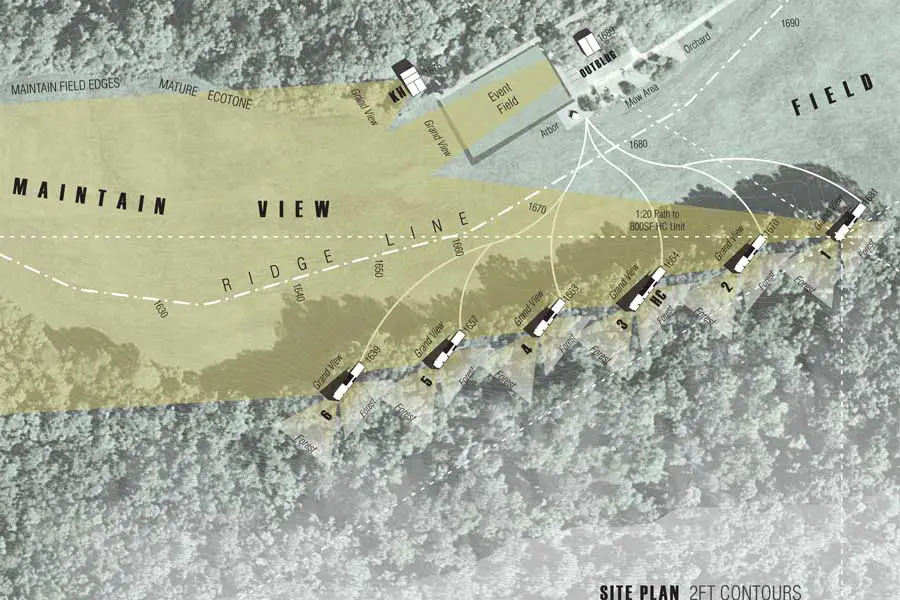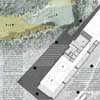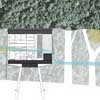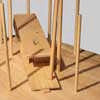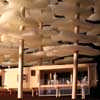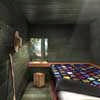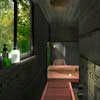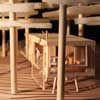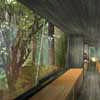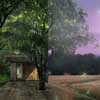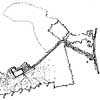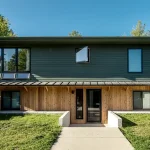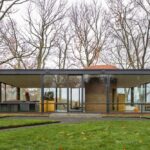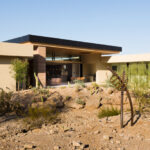Fallingwater On-Site Cottages Contest, Pennsylvania Architecture Competition, PA Building Architect
Fallingwater On-Site Cottages, Pennsylvania, United States
Mill Run Design Competition, PA design by Wendell Burnette Architects, USA
May 28, 2010
Design: Wendell Burnette Architects
Second-Place Winner of Design Competition for On-Site Cottages
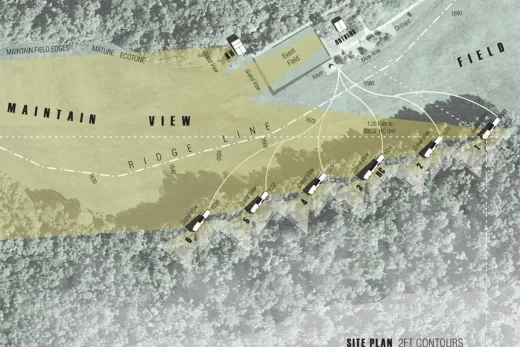
image : Wendell Burnette Architects | Michael Boucher Landscape Architecture
Fallingwater Cottages
Our proposal for the fallingwater cottages is about receding into the edge condition between forest and field. It is against object architecture and instead is for an architecture that fosters authentic experience of place. Cottages are sited out of the field as was the Kirkpatrick House, which respected the field as a working farm and the ecotone or “edge community” as a refuge of shade and as a place of prospect.
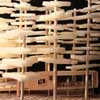
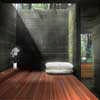
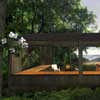
images : Wendell Burnette Architects | Michael Boucher Landscape Architecture
Our response to the broad regional initiative to reforest fields is to do so only in select areas that maintain the agricultural authenticity of the field landscape. We support re-establishing the historic access way with a straight farm road from the highway buildings along the edge of the old farm and aligned with a smaller sunset field / reforested edge. At the intersection of fields one turns a sharp corner and the much larger Kirkpatrick Field spreads out to the south and over the horizon to the west.
Precisely at the point of greatest prospect where the field rolls down and outward toward an expansive view across the accordant summits of the allegheny mountain range – sits the Kirkpatrick House. We propose to reinforce its’ role as the educational outreach hub by focusing existing buildings, orchard, arbor, and drives around a quad or event field, which also aggregates autos to the north field edge preserving and reinforcing its’ most significant aspect.
Fallingwater On-Site Cottages Contest
The cottages are embedded in the shady south field edge opposite the Kirkpatrick House. The daily traversing of the field between community and the individual / group is a central part of our concept. The field and forest edges that define and extend it out through the grand view window to the west are each ever changing at micro / macro scales. A slow walk across the field is perhaps the most memorable experience you take with you.
The cottages are both threshold and fulcrum between field and forest. Stones from the field edge serve as a stepping-stone onto a simple timber plank that extends the plane of the field into the forest, which combines with the canopy of the ecotone forest to create a threshold. The solid timber cabin is choreographed as an instrument of experience to extend one into the oak-hickory forest, its dappled light and shade, its omni-present textures, its sounds, and its cooler environs – along the way elevating one slightly above the forest floor and capturing the long-view over the field ridgeline.
Their long e-w form and turned solar orientation follows fallingwater and the old Kaufmann Dairy Barn to capture the morning sun (as many FLLW’s buildings do), while opening all private and public spaces to the grand view to the west / northwest under the protective shade of the forest edge. Strategically placed cross-ventilation doors and windows designed for use in rain or shine harness natural convection currents that pull cooler air from bear run (and lower points beyond) up the south slope through the long cabin out toward the field that superheats in the summer creating a thermal siphon. The natural cooling effects of shade and evapotranspiration provided by the forest are utilized in lieu of additive architectural devices such as overhangs and shade louvers.
The wood cabins are not an abstraction of the forest they are constructed of the forest. They are designed to tell the story of this oak-hickory forest through the sheer weight, finesse and tactility of its’ materiality as well as the human story of this region through its’ craft and making. We propose that a monoculture of spruce could be harvested by one of the local timber mills and milled to specification for each cabin’s structure and thermal envelope requirements.
The main structure could possibly be erected in conjunction with architecture design-build programs directed by amish master woodworkers nearby or by them exclusively. Solid timber construction is a single-stroke solution for structure, exterior and interior finish, and a thermal envelope that controls room temperature and regulates humidity. It also acts as a long-term carbon store with a smaller carbon footprint than any other local material we could use.
The long narrow form allows it to be threaded between the existing trees such that no tree is cut. 8-10 screw pile or hand dug foundations minimize disturbance of the forest floor while supporting a level platform from which to build this simple structure of prefabricated componentized parts. The construction site is designed to be an assembly site of parts in lieu of conventional “layered construction” to minimize site time, site disturbance and hold total construction costs at the $150-200SF budget.
LEED Platinum is an attainable and realistic goal with our design approach and the anticipated tie-in to the existing zero-discharge wastewater reclamation system. A ground supported photovoltaic array extending the east end of the orchard could incrementally provide power for all six cabins as they are built out.
The 633NSF cabin can sleep one to ten; an individual, a couple, a family, or a group i.e. One professor (chaperon) in the private bedroom and eight students along the public edge “hostel style” while still feeling like an intimate cottage or home in any situation.
The rich gravitas of the forest will be felt from the moment one steps onto the solid massive plank – akin to walking upon a fallen tree as a child – to the moment when one closes a beautifully crafted cedar-lined chestnut-faced drawer tested over time to perfectly suit its’ function. The plank organizes the public program along its edges around the private / servant program, which withholds the grand view until precisely the point it can be attained over the field ridgeline under the protective shade of the forest edge.
This public edge on two of three sides is open to the oak-hickory forest and receives the dappled sunlight streaking through its’ canopy. All spaces benefit from this light and carefully considered cross-ventilation even during the frequent rain greatly reducing reliance on energy. The main living space can be thought of as an under-cover exterior screened terrace – balcony when the large window is opened toward the forest floor stopping as a guardrail.
Other finer things that the hand touches with the eye and the hand would celebrate the hardwoods abundant in the area; hickory, silver and red maple, white, red and chestnut oak. More specialty items such as steel, metal, and glass will come only as far away as Pittsburgh. Additionally, we propose to finish the spruce utilizing the ancient Japanese tradition of charring boards, which provides protection against water, insects, and fire. The silvery-black charred wood boards will recede into the forest shadows and further presence the dappled light and textures of the forest, the grand view, and the finer warm woods.
Details like: firewood storage, a mud room entry with a walk-off grating that drains plus an ample closet for group coats / shoes, a writing desk with a view, a ventilating skylight above your sleeping head to view trees / sky / stars, a private toilet separate from private bath, lounge spaces along the public edge double as sleeping berths and luggage storage for eight, are all carefully integrated and considered.
Fallingwater is famous because the house in its setting embodies a powerful ideal – that people today can learn to live in harmony with nature… As technology uses more and more natural resources, as the world’s population grows even larger, harmony with nature is necessary for the very existence of mankind. – Edgar kaufmann, jr., 1978
The scholar cottages have the unique opportunity – as an extension of educational outreach programs – to compliment the “Powerful ideal” Edgar Kaufmann, jr. espoused, similar to wright’s “Usonia No. 1”
Fallingwater On-Site Cottages images / information from Wendell Burnette Architects
Location: Fallingwater, Pennsylvania, United States of America
Pennsylvania Buildings
APPC Building, Philadelphia
Maki and Associates

photo SCHOTT USA © Jeffrey Totaro
Westmoreland Museum of American Art
Design: Susan T. Rodriguez of Ennead Architects

image from architects
Fallingwater
Date built: 1935
Design: Frank Lloyd Wright architect
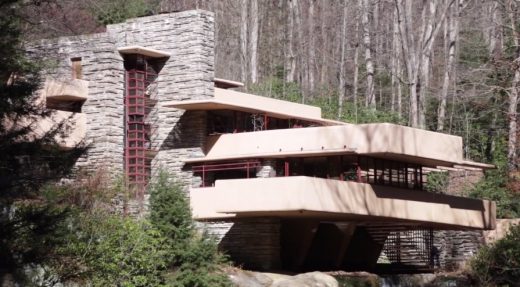
photo : Simon Garcia | arqfoto.com
Fallingwater by Frank Lloyd Wright
Most famous Pennsylvania building? Fallingwater by Frank Lloyd Wright
Pennsylvania Buildings : Philadelphia
American Architecture Designs
American Architectural Designs – recent selection from e-architect:
Comments / photos for the Fallingwater On-Site Cottages Competition, Mill Run – Pennsylvanian Architecture page welcome.

